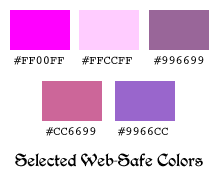


 |  |  |
RGB color space is essentially an additive color space. Subtractive colors are the sorts of colors you use with paints and pigments; additive colors are those involved with colors of light. Computer monitors use light to display colors; therefore, RGB color space is additive. When you add more subtractive colors together, you eventually get black; when you add more additive colors together, you eventually get white. With subtractive colors, red and green make brown; with additive colors, red and green make yellow.
In RGB color space, add red and green to get yellow, add green and blue to get aqua, add red and blue to get violet, and add red, green, and blue in equal proportions to get shades of gray. The less color you add, the blacker it will be; the more color you add, the whiter it will be. To reduce the saturation of a color, add more of its opposite; for instance, #FF00FF makes a brilliant, saturated shade of violet, whereas #FFCCFF makes a very pastel violet and #996699 makes a medium-toned, unsaturated violet. #CC6699 might make a pinker violet color, whereas #9966CC makes a bluer violet color.

Copyright © 2001 Michael Masumoto. All Rights Reserved.